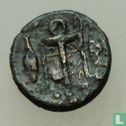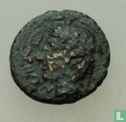

Enlarge image


Catalogue information
LastDodo number
7224791
Area
Coins
Title
Leontini, Sicily AE14 (Trias, 3/12 Litra, Tripod Altar, Ancient Greece) 405-402 BCE
Country
Face value
Year
-405
Variety / overstrike
Head of State
Type
Designer
Series
Material
Weight
2.2
Diameter
14
Thickness
Punch
Shape
Obverse
3 (pellets)
Reverse
LEON
Edge
Privy mark
Mint mark
Number produced
Krause and Mishler number
Catalogue number
SNG ANS 270; Calciati III pg. 79, 3/27; BMC Sicily pg. 92, 56; SNG Copenhagen 360; SNG Morcom 606; Laffaille 169; Virzi 1039
Details
Obv; Tripod Altar, lyre behind central leg, barley grain on either side; three pellets in exergue.
Rev; LEON, laureate head of Apollo left (usually right); laurel leaf with berry behind
The city was founded by colonists from Naxos as Leontini in 729 BC,[1] which in its beginnings was a Chalcidian colony established five years earlier.
Leontini is virtually the only Greek settlement in Sicily that is not located on the coast, founded around 6 miles inland. The site, originally held by the Sicels, was seized by the Greeks owing to their command on the fertile plain in the north. The city was reduced to subject status in 494 BC by Hippocrates of Gela, who made his ally Aenesidemus its tyrant. In 476 BC, Hieron of Syracuse moved the inhabitants from Catana and Naxos to Leontini.
Later on, the city of Leontini regained its independence. However, as a part of the inhabitants efforts to retain their independence, they invoked more than once the interventions of Athens. It was mainly the eloquence of Gorgias of Leontini which led to the abortive Athenian expedition of 427 BC.
In 422 BC, the Greek city-state of Syracuse supported the oligarchs against the people and received them as citizens, Leontini itself being forsaken. This led to a renewed Athenian intervention. Initially as a diplomatic one, the exiles of Leontini joined the envoys of Segesta in persuading Athens to undertake the great Sicilian Expedition of 415 BC.
After the failure of the Expedition, Leontini became subject to Syracuse once more. The city's independence was guaranteed by the treaty of 405 BC between Dionysius and the Carthaginians, but it was soon lost again. The city was finally stormed by Marcus Claudius Marcellus in 214 BC.
a bit north of Syracuse



